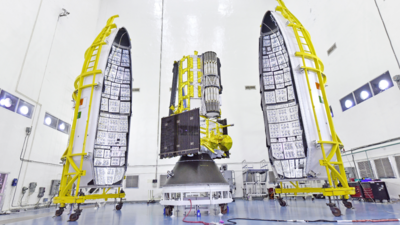Unlike optical sensors, the synthetic aperture radar (SAR) at the heart of the Nisar mission expected to launch at 5.40pm today (July 30), doesn’t rely on visible light. SAR uses microwaves, allowing satellites to “see” through clouds and operate day or night. This capability makes SAR a powerful tool for monitoring everything from Antarctic ice to earthquakes and deforestation.From conventional radar to SARConventional radar systems send out microwave pulses that bounce off the Earth’s surface. The radar then captures the returning echoes, measuring how long the signal took to return, its strength, and frequency shifts. These data reveal information about the object’s distance, movement, and texture — but not with high visual clarity.SAR takes this concept further by adding movement and computation into the equation. As a satellite like Nisar orbits Earth, its radar antenna continues to emit and receive microwave pulses. Since the satellite is moving, each return signal comes from a slightly different angle. These slight differences create changes in the frequency of the returned signal — a phenomenon known as the Doppler shift, familiar from how a siren sounds different when approaching and then receding.Synthesising an antennaOrdinarily, to get a radar image with high resolution, one would need a physically enormous antenna — too big to launch or operate in space. For example, Nisar’s L-band radar would need a 19-km-wide antenna to produce 10-metre resolution images using traditional radar techniques. Instead, SAR “synthesises” a large antenna using the movement of a smaller one over time. Nisar’s actual radar antenna spans 12 metres when deployed — about the length of a city bus — but through SAR processing, it achieves resolution comparable to that of a much larger antenna.In effect, SAR uses the satellite’s forward motion to simulate a larger antenna. It stitches together multiple radar returns, aligning them through complex onboard data processing. The spacecraft’s flight path becomes like a camera lens sweeping across a landscape, focusing the echoes into a sharp, high-resolution image.Visualising with SAROnce the raw SAR data are collected, they can be processed into different types of images for scientific analysis.■ Interferometry (InSAR): By comparing two SAR images of the same location taken at different times, scientists can produce an interferogram. These look like colourful contour maps and highlight subtle shifts in land elevation — crucial for monitoring earthquakes, landslides, and glacier movement. The closer the bands in the image, the greater the surface displacement.■ Polarimetry: This involves analysing how radar waves are oriented when they return. For example, vertical structures like buildings often reflect waves in the same orientation they were sent, while complex, irregular surfaces like tree canopies alter that orientation. This helps researchers distinguish between different types of land cover and assess damage after floods or storms.Why SAR mattersSAR’s ability to observe surface change in any weather, at any time, makes it essential for studying Earth’s dynamic systems. It supports disaster response, environmental monitoring, and climate science. For example, SAR can measure how much a glacier has retreated, track soil moisture changes during droughts, or detect whether land near a fault line has subtly shifted.As Charles Elachi, former director of Nasa’s Jet Propulsion Laboratory, puts it: SAR “allows us to refine things very accurately.” By capturing frequent and detailed images of the same locations, missions like Nisar can monitor change over time, turning raw radar echoes into critical knowledge about Earth’s evolving surface.






